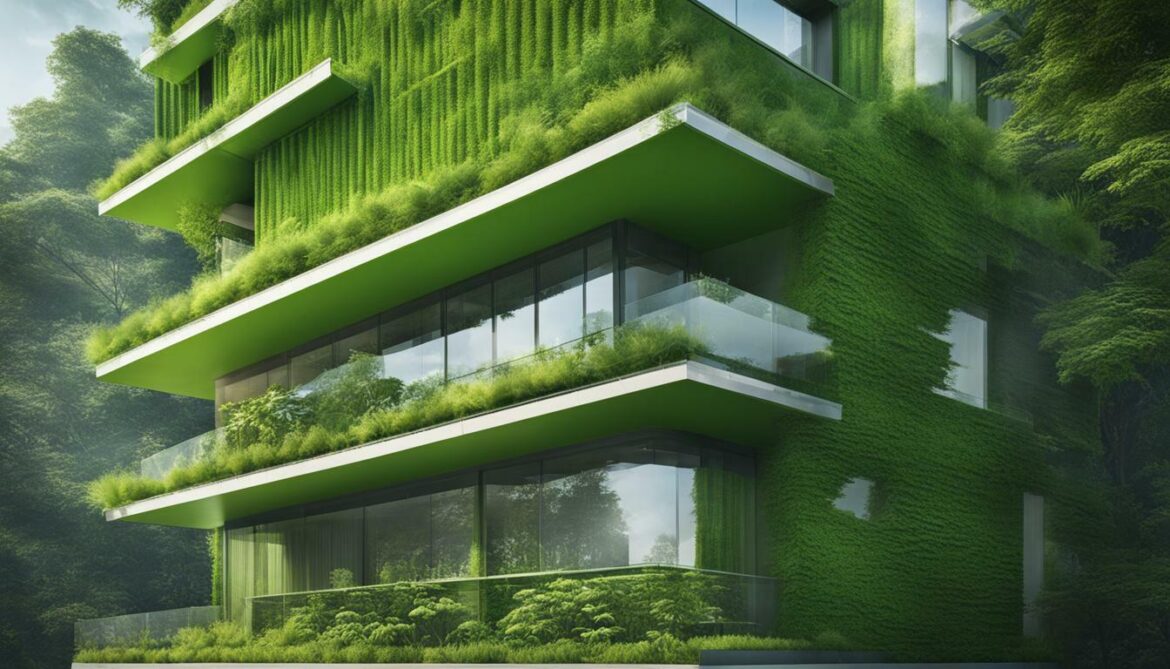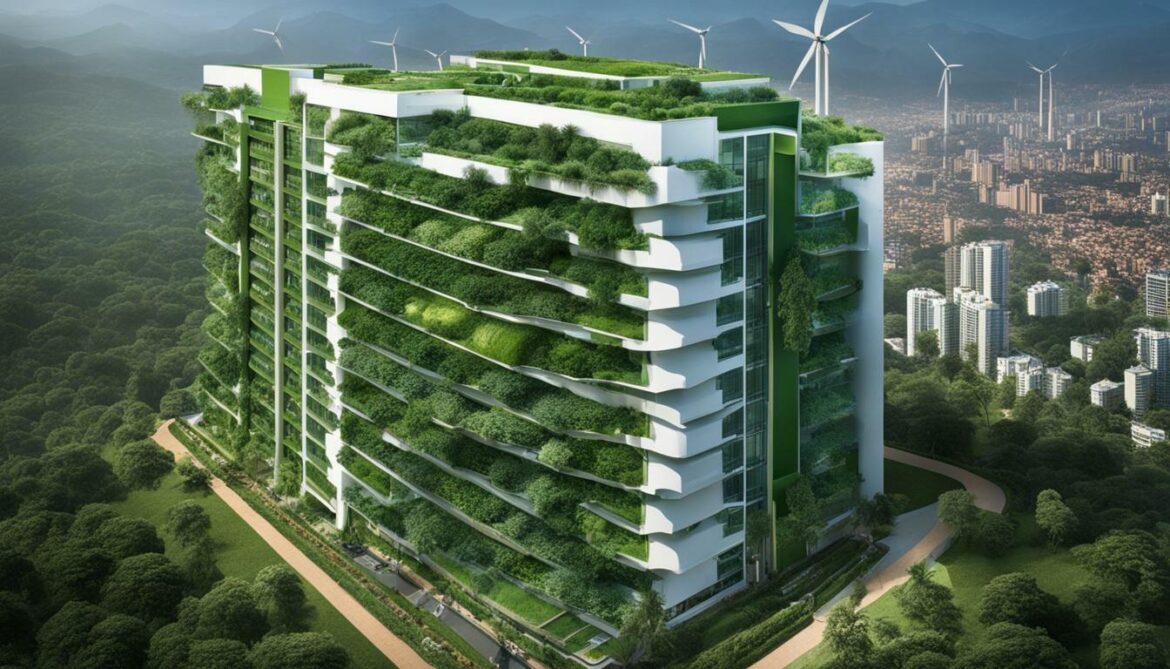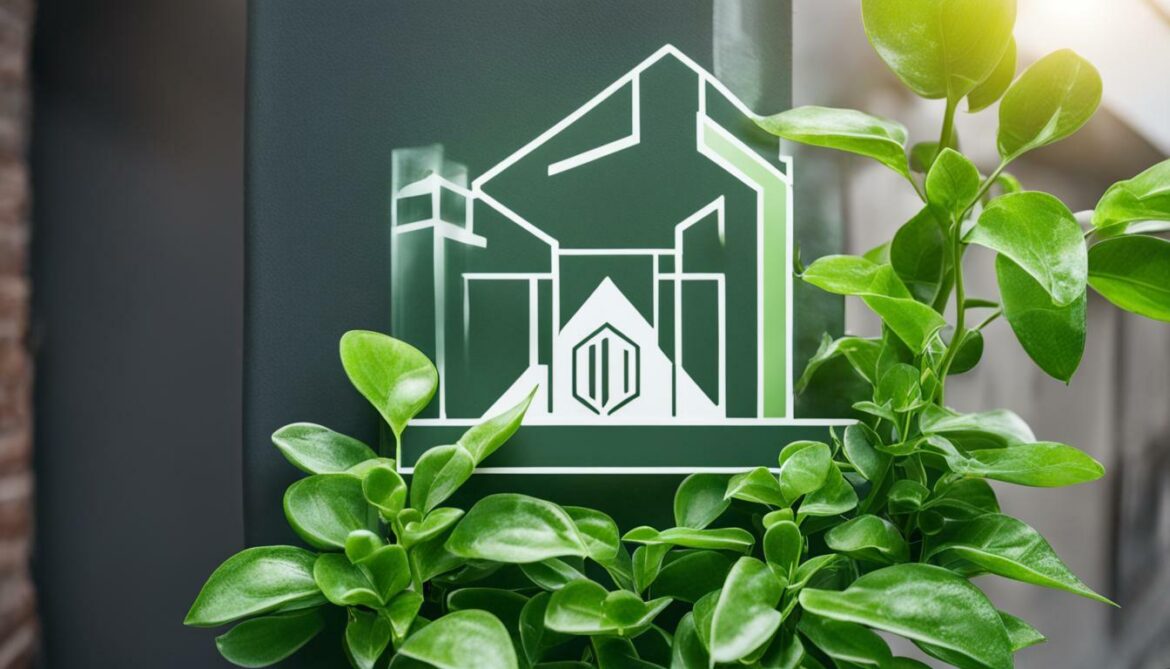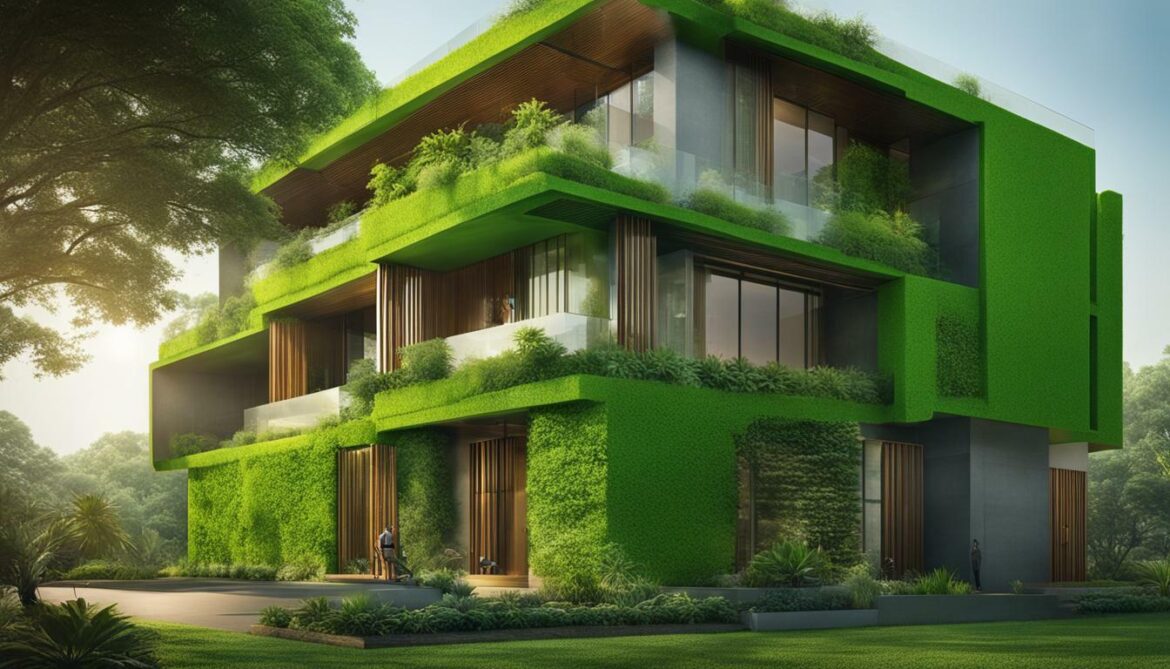The history of green building practices in India dates back to ancient times, with a focus on maximising natural resources and minimising environmental impact. In the past, buildings in India were designed to harmoniously coexist with nature, incorporating sustainable techniques that are still relevant today.
Ancient Indian architecture embraced eco-friendly principles and sustainable construction methods. Buildings were crafted to take advantage of natural light and ventilation, reducing the need for artificial energy consumption. The use of open spaces and courtyards helped to create a connection between the indoors and outdoors, while also promoting natural airflow. Additionally, water storage and prayer rooms were strategically positioned to benefit from solar disinfection.
Key Takeaways:
- India has a long-standing tradition of green building practices.
- Ancient Indian architecture focused on maximising natural resources and minimising environmental impact.
- Techniques such as natural light and ventilation, open spaces, and proper water storage were incorporated.
- The Indian Green Building Council (IGBC) was established in 2001 to promote green building initiatives.
- The IGBC has developed rating systems for different types of buildings to encourage sustainable design.
The rich heritage of green building practices in India has laid a foundation for the modern sustainable construction movement. Today, there is a growing emphasis on incorporating eco-friendly materials, reducing energy consumption, and creating healthier indoor environments. With the continued efforts of organizations like the IGBC and the support of states and local bodies, India is on a path towards a greener and more sustainable future.
Ancient Green Building Techniques in India
Ancient Indian architecture employed various sustainable techniques, such as utilizing natural light and ventilation, incorporating open spaces and courtyards, and positioning water storage and prayer rooms in specific directions for solar disinfection. These practices were deeply rooted in Vedic philosophy and aimed to create harmonious built environments that respected nature and promoted well-being.
“The principles of ancient Indian architecture were intrinsically linked to sustainable practices, with a focus on harmony between human habitation and the natural world.”
One of the key techniques used in ancient India was the utilization of natural light and ventilation. Buildings were designed with large openings and strategically placed windows to maximize the entry of sunlight and fresh air, reducing the need for artificial lighting and mechanical ventilation systems. This not only minimized energy consumption but also created healthier and more comfortable living spaces.
Another sustainable technique employed was the incorporation of open spaces and courtyards. These open areas served multiple purposes, including providing natural cooling, promoting cross-ventilation, and creating a connection with nature. They also facilitated social interactions and community bonding, reflecting the holistic approach to architecture in ancient India.
Furthermore, water storage and prayer rooms were positioned in specific directions to harness the power of the sun for disinfection purposes. The ancient Indians understood the benefits of solar energy and used it effectively to purify water for drinking and bathing. This practice not only ensured access to clean water but also reduced the reliance on chemical disinfection methods.

| Technique |
Description |
| Natural Light and Ventilation |
Maximizing the use of sunlight and fresh air to reduce energy consumption and create healthier indoor environments. |
| Open Spaces and Courtyards |
Incorporating open areas for natural cooling, cross-ventilation, and social interactions. |
| Solar Disinfection |
Positioning water storage and prayer rooms to utilize the sun’s power for water purification. |
Ancient Indian architecture serves as a source of inspiration for modern sustainable construction practices. By embracing the wisdom of the past and incorporating it into contemporary design, India continues to promote green building practices that contribute to a more sustainable future.
The Rise of Green Building Initiatives in India
Over the years, India has witnessed the rise of green building initiatives aimed at promoting sustainable architecture and design. As the country grapples with the environmental challenges posed by rapid urbanization and industrialization, these initiatives have gained momentum and are shaping the future of India’s built environment.
One notable organization leading this movement is the Indian Green Building Council (IGBC), which was established in 2001. The IGBC plays a crucial role in promoting green building practices by setting standards and providing certification for environmentally friendly buildings. Their efforts have resulted in the development of innovative and sustainable design solutions that are tailored to the Indian context.
The IGBC has introduced a range of rating systems for different types of buildings, ensuring that sustainability principles are incorporated into every aspect of the construction process. These rating systems cover various areas, including site selection, water and energy efficiency, use of sustainable materials, and indoor environmental quality. By encouraging builders and designers to meet these standards, the IGBC is driving the adoption of green building practices across the country.
| Type of Building |
IGBC Rating System |
| New Buildings |
IGBC Green Building Rating System |
| Existing Buildings |
IGBC Green Existing Buildings O&M Rating System |
| Homes |
IGBC Green Homes Rating System |
| Healthcare Facilities |
IGBC Healthcare Rating System |
| Schools |
IGBC Green Schools Rating System |
India’s commitment to green building practices has earned global recognition. In 2016, the country ranked third in the US Green Building Council’s annual ranking for LEED certified buildings. Additionally, several states and local bodies in India offer incentives for green buildings, such as increased floor-to-area ratios, tax benefits, and expedited approvals. These measures create a favorable environment for developers and encourage the widespread adoption of sustainable construction practices.

With a focus on reducing greenhouse gas emissions, conserving resources, and improving occupant health and well-being, India’s green building movement is driving change in the construction industry. By embracing green building initiatives and incorporating sustainable design principles, India is laying the foundation for a more sustainable future.
The Role of the Indian Green Building Council (IGBC)
The Indian Green Building Council (IGBC) was established in 2001 as a key player in promoting green building practices and certifying environmentally friendly buildings. The council has been instrumental in driving the adoption of sustainable construction techniques and fostering a culture of eco-friendly buildings in India.
Under the leadership of the IGBC, green building design in India has seen significant advancements. The council has developed comprehensive rating systems for various types of buildings, ensuring that sustainable practices are incorporated into every aspect of the construction process. These rating systems cover a wide range of criteria, including energy efficiency, water conservation, waste management, and indoor air quality.
The IGBC also plays a crucial role in providing certification for green buildings, which helps in verifying their adherence to sustainable practices. Buildings that meet the stringent criteria set by the council are awarded certification, giving them recognition for their commitment to environmental responsibility.

Furthermore, the IGBC actively promotes the use of green building materials in India, advocating for the use of sustainable resources and minimizing the environmental impact of construction. By encouraging the adoption of eco-friendly materials, the council aims to create a more resilient and sustainable built environment.
Benefits of IGBC Certification
Obtaining IGBC certification for a building brings various advantages. Firstly, it enhances the market value of the property, as green buildings are highly sought after by environmentally conscious buyers and tenants. Secondly, green buildings are known to have lower operational costs due to their energy-efficient design, resulting in significant savings on utility bills. Additionally, green buildings provide a healthier indoor environment, improving the well-being and productivity of occupants.
Achieving a Sustainable Future
The efforts of the Indian Green Building Council (IGBC) have been instrumental in driving the adoption of green building practices in India. With their comprehensive rating systems, the council ensures that sustainability is at the core of every construction project. By championing eco-friendly materials, energy efficiency, and waste management, the IGBC is paving the way towards a more sustainable and resilient future for India’s built environment.
| Key Focus Areas of IGBC Certification |
Benefits |
| Energy efficiency |
Reduced operational costs and lower carbon footprint |
| Water conservation |
Efficient use of water resources and reduced water consumption |
| Waste management |
Minimized waste generation and improved environmental performance |
| Indoor air quality |
Healthier indoor environment for occupants |
| Sustainable materials |
Reduced environmental impact and conservation of natural resources |
Rating Systems for Green Buildings in India
The Indian Green Building Council (IGBC) has developed a range of rating systems that evaluate different aspects of green building design and provide guidance for developers and architects. These rating systems are designed to promote sustainable practices and encourage the construction of environmentally friendly buildings in India.
One of the key rating systems developed by the IGBC is the Green Homes Rating System, which evaluates the environmental performance of residential buildings. This rating system assesses various factors, including site selection and planning, water efficiency, energy efficiency, materials and resources, indoor environmental quality, and innovation in design processes. By following the guidelines set by the Green Homes Rating System, developers and architects can create homes that are energy-efficient, water-efficient, and have a reduced carbon footprint.
In addition to the Green Homes Rating System, the IGBC has also developed rating systems for other types of buildings, such as offices, schools, healthcare facilities, and existing buildings. These rating systems address specific requirements and challenges associated with each building type, ensuring that they meet the highest standards of sustainability.
The rating systems provided by the IGBC play a crucial role in promoting green building practices in India. They provide a framework for developers and architects to design and construct buildings that are environmentally friendly and energy-efficient. By participating in the IGBC’s rating systems, building owners can also receive recognition and certification for their efforts in creating sustainable buildings.
To fully understand the impact of the IGBC’s rating systems, it is worth noting that, as of 2021, over 6,400 projects in India have been registered under the IGBC rating systems. This demonstrates the growing awareness and adoption of green building practices in the country.
By implementing these rating systems, India is taking significant steps towards creating a more sustainable built environment. These initiatives not only benefit the environment but also contribute to the health and well-being of occupants. Through the guidance provided by the IGBC, developers and architects can play a vital role in shaping the future of sustainable architecture in India.
| Type of Building |
Rating System |
| Residential |
Green Homes Rating System |
| Commercial |
Green Building Rating System |
| Schools |
Green Schools Rating System |
| Healthcare Facilities |
Green Healthcare Facilities Rating System |
| Existing Buildings |
Existing Building Performance Rating System |
Key Benefits of IGBC Rating Systems:
- Promote sustainable building practices
- Encourage energy efficiency and water conservation
- Improve indoor air quality and occupant comfort
- Reduce greenhouse gas emissions
- Recognize and certify environmentally friendly buildings
- Contribute to a more sustainable built environment in India
“The IGBC’s rating systems are instrumental in driving the adoption of green building practices in India. By providing clear guidelines and certification, they empower developers and architects to design and construct buildings that are both environmentally friendly and financially viable.” – Architectural Digest

Recognition and Incentives for Green Buildings in India
India’s dedication to green buildings has gained global recognition, with the country ranking third in LEED certified buildings in 2016. This achievement highlights India’s commitment to sustainable construction and environmentally friendly practices. The Indian Green Building Council (IGBC) has played a crucial role in promoting and certifying green buildings, leading to increased incentives and recognition for developers and owners.
One of the key incentives for green buildings in India is the provision of extra floor-to-area ratio (FAR). This allows developers to construct additional floor space beyond what is normally allowed, giving them a competitive advantage in the market. The provision of extra FAR incentivizes developers to incorporate green building practices, as it not only benefits the environment but also enhances the financial viability of their projects.
In addition to extra FAR, several states and local bodies in India offer other incentives such as tax benefits, expedited approvals, and grants for green building projects. These incentives serve as a way to encourage more developers and owners to embrace sustainable construction practices and contribute to the growth of the green building sector in the country.
| Recognition and Incentives for Green Buildings in India |
| Third ranking in LEED certified buildings in 2016 |
| Extra floor-to-area ratio (FAR) for green buildings |
| Tax benefits, expedited approvals, and grants |
India’s dedication to green buildings and the incentives provided for their construction have not only contributed to the sustainable development of the built environment but have also had a positive impact on the economy. Green buildings help reduce energy consumption, lower greenhouse gas emissions, and promote a healthier and more productive indoor environment. By recognizing and incentivizing green building initiatives, India is positioning itself as a leader in sustainable architecture and making significant progress towards a greener and more sustainable future.

The evolution of green building practices in India demonstrates the country’s commitment to reducing environmental impact and creating a sustainable built environment. India has a rich history of green building practices that date back to ancient times. Buildings were designed to maximize the use of natural resources and minimize their impact on the environment. These practices, rooted in Vedic philosophy, included techniques such as utilizing natural light and ventilation, incorporating open spaces and courtyards, and positioning water storage and prayer rooms in specific directions for solar disinfection.
In recent years, India has taken significant steps to promote green building practices and create a sustainable future. The Indian Green Building Council (IGBC), established in 2001, plays a vital role in this endeavor. The IGBC promotes green building initiatives and provides certification for environmentally friendly buildings. They have developed a range of rating systems for various building types, incorporating aspects such as site selection, water and energy efficiency, sustainable materials, indoor environmental quality, and innovative design processes.
India’s efforts in promoting green buildings have gained global recognition, with the country ranking third in the US Green Building Council’s annual ranking for LEED certified buildings in 2016. Moreover, several states and local bodies in India provide incentives for green buildings, including extra floor-to-area ratio. These incentives encourage developers to adopt green building practices, further driving the sustainable construction movement in India.
The adoption of green building practices in India is vital in addressing the environmental challenges posed by the construction industry. It not only helps in reducing greenhouse gas emissions and conserving resources but also improves occupant health and well-being. India’s dedication to sustainable architecture and green building initiatives signifies the country’s commitment to a greener future, one that prioritizes the well-being of both people and the planet.
FAQ
What is the history of green building practices in India?
Green building practices in India date back to ancient times, where buildings were designed to maximize the use of natural resources and minimize their impact on the environment. These practices were rooted in Vedic philosophy and incorporated techniques such as utilizing natural light and ventilation, incorporating open spaces and courtyards, and positioning water storage and prayer rooms in specific directions for solar disinfection.
What initiatives are promoting green building practices in India?
India has taken steps to promote green building practices through the establishment of the Indian Green Building Council (IGBC) in 2001. The IGBC provides certification for environmentally friendly buildings and has developed a range of rating systems for different types of buildings. These initiatives aim to incorporate aspects of green building design, such as site selection and planning, water efficiency, energy efficiency, use of sustainable materials, indoor environmental quality, and innovation in design processes.
What is the role of the Indian Green Building Council (IGBC) in promoting green building practices?
The Indian Green Building Council (IGBC) plays a significant role in promoting green building practices in India. It provides certification for sustainable buildings and sets standards for green building design and construction. The IGBC also educates and raises awareness about the benefits of green buildings and supports the development of innovative solutions for the built environment.
What rating systems exist for green buildings in India?
The Indian Green Building Council (IGBC) has developed various rating systems for different types of buildings, including new buildings, existing buildings, homes, healthcare facilities, schools, and more. These rating systems assess different aspects of green building design, such as site selection and planning, water efficiency, energy efficiency, use of sustainable materials, indoor environmental quality, and innovation in design processes.
Have India’s green building efforts been recognized globally?
Yes, India’s green building efforts have gained recognition globally. In 2016, India ranked third in the US Green Building Council’s annual ranking for LEED certified buildings. Several states and local bodies in India also provide incentives for green buildings, such as extra floor-to-area ratio, further highlighting the recognition and support for sustainable construction in the country.
What is the significance of green building practices in India?
Green building practices in India are crucial in addressing environmental challenges posed by the construction industry and creating a sustainable future. By reducing greenhouse gas emissions, conserving resources, and improving occupant health and well-being, green buildings contribute to a more sustainable built environment and a healthier planet.
Source Links























Post comments (0)